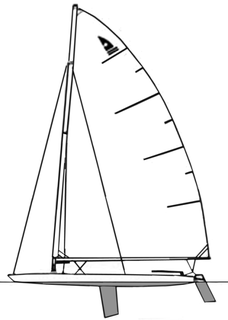
The Lightning is an American sailing dinghy that was designed by Olin Stephens of Sparkman & Stephens, as a one-design racer and first built in 1938.

The Vanguard 15 is an American sailing dinghy that was designed by Bob Ames as a one-design racer and first built in 1992.

The C Scow is an American sailing dinghy that was designed by John O. Johnson as a one-design racer and first built as early as 1905. Sources disagree as to the first-built date, with claims of 1905, 1906 and 1923.

The Windmill is an American sailing dinghy that was designed by Clark Mills as a one-design racer and first built in 1953.

The Bombardier Invitation is a Canadian sailing dinghy that was designed by Bombardier Research to compete in the same market with the Laser, as a one-design racer. It was first built in 1973.
The Blue Crab 11, also called the Gloucester 11, is an American utility dinghy that can be rowed, used as a motorboat or as a sailing dinghy. It was designed by Harry R. Sindle and first built in 1971. The design is named for the family of crustaceans.
The Puffer is an American rowboat, motorboat and sailing dinghy that was designed by Fred Scott and first built in 1972.
The Capri Cyclone, also referred to as the Cyclone 13 or just the Cyclone, is an American sailing dinghy that was designed by Frank V. Butler as a one-design racer and first built in 1970.
The Barnett 1400 is an American sailing dinghy that was designed by Ron Hedlund and Gerry Hedlund as a one-design racer and first built in 1989.
The Cheshire 14 is an American catamaran sailing dinghy that was designed by Frank Meldau as a racer and first built in 1962.

The Hobie 14 is an American catamaran sailing dinghy that was designed by Hobie Alter and first built in 1967.
The Trac 14 is an American catamaran sailing dinghy that was designed by Australians Richard McFarlane and Jay McFarlane as a one-design racer and first built in 1980.
The Phantom 14 is an American sailing dinghy that was designed by Jack Howie as a racer and first built in 1977. It is a board sailboat, similar to the Sunfish.
The Nacra 5.2 is an American catamaran sailing dinghy that was designed by Tom Roland as a one-design racer and first built in 1975. Other that the small production run Nacra 36, the Nacra 5.2 was the first Nacra brand boat and established its reputation.
The Dolphin 15 Senior, sometimes referred to as just the Dolphin Senior, is an American sailing dinghy that was designed by brothers Glenn Corcoran and Murray Corcoran and first built in 1964.
The Skipjack 15 is an American sailing dinghy that was designed by Harry R. Sindle and Carter Pyle and first built in 1965.
The Designers Choice is an American sailing dinghy that was designed by Sparkman & Stephens as a sail training and racing boat and first built in 1978. It was Sparkman & Stephens' design #2349.
The G-Cat 5.0 is an American catamaran sailing dinghy that was designed by Hans Geissler as a one-design racer and first built in 1975.
The G-Cat 5.7 is an American catamaran sailing dinghy that was designed by Hans Geissler as a one-design racer and first built in 1980.
The Prindle 18 is an American catamaran sailing dinghy that was designed by Geoffrey Prindle as a racer and first built in 1977.







